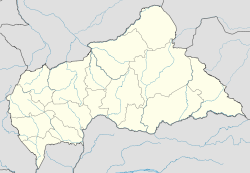Lidjombo
Lidjombo | |
|---|---|
| Coordinates: 2°42′8″N 16°6′2″E / 2.70222°N 16.10056°E | |
| Country | Central African Republic |
| Prefecture | Sangha-Mbaéré |
| Sub-prefecture | Bayanga |
| Commune | Yobe-Sangha |
| Area | |
| • Total | 2.9 sq mi (7.6 km2) |
| Population (2021) | |
| • Total | 971[1] |
Lidjombo, also spelled Lindjombo, is a village located in the southern prefecture of Sangha-Mbaéré, Central African Republic. It is situated within the Dzanga-Sangha Special Reserve.
In the past, the villagers heavily relied on coffee farming and logging for their livelihood. However, those two sectors ended their operations 1980s, making Lidjombo declared a "dead town."[2][3]
Etymology[edit]
The name of the village originated from a name of fish, Jombo, that was ubiquitous across Sangha River when the village was established.[4]
History[edit]
Some people who did not like to work at the coffee plantation in Mompagana moved from the village and founded a settlement named Lidjombo in 1919.[4] In the mid-1920s, Santini and Lopez built coffee plantations in the village, drawing many Mpiemu, Gbaya, and Baka to dwell in the village.[5][6]
Around the mid-50s, Lidjombo faced a coffee boom and it attracted many people to migrate to the village because of the good salary.[6][7] However, the coffee production ceased operation in 1981 after the owner left the village. As a result, the coffee farm is covered by vines.[8][2] Nevertheless, as of 1988, the former coffee plantation workers remained in Lidjombo.[9]
In April 2013, Front pour la Libération et l'Indépendance de la Sangha-Mbaéré (FLISM) controlled Lidjombo.[10]
Demography[edit]
Lidjombo is a multi-ethnic settlement. Various ethnic groups, which are Sangha Sangha, Mpiemo, Mbaya, Kaké, Manja, Gbaka, Banda, Bossa-Goma, and Baka people inhabit the village.[4]
Economy[edit]
The villagers depend on several sectors for their livelihood, such as farming, hunting, gathering, distilling local alcohol, and commerce.[4]
Education[edit]
The village has one primary school.[4]
Healthcare[edit]
Lidjombo has one health post.[11]
Security[edit]
The village's security is served by a police post and a national Gendarme Brigade office.[4]
Transport[edit]
In 1976 a logging company, Slovenia-Bois, built a road connecting the Lidjombo to the rest of the country, thus freeing the village from isolation.[12]
References[edit]
- ^ "Dzanga Sangha Protected Areas Newsletter May 2021" (PDF). Dzanga Sangha Protected Areas. May 2021. Retrieved 26 October 2023.
- ^ a b Giles-Vernick, Tamara (2000). "Doli: Translating an African Environmental History of Loss in the Sangha River Basin of Equatorial Africa". The Journal of African History. 41 (3): 384. doi:10.1017/S0021853700007702. S2CID 143691556.
- ^ Noss 1995, p. 120.
- ^ a b c d e f Che, Victorine S. (2008). "4". A Critical Analysis of the Interrelation between Indigenous Livelihoods and Sustainable Forest Management - Integrating Gender Aspects. Case of the Sangha Trinational Conservation Area (Thesis). Albert Ludwig University of Freiburg. p. 92.
- ^ Noss 1995, p. 95.
- ^ a b Jost, Carolyn A. (2012). "2". Beyond hunters and hunted: An integrative anthropology of human-wildlife dynamics and resource use in a central African forest (Thesis). Purdue University. p. 44.
- ^ Giles-Vernick, Tamara (1999). "Leaving a Person behind: History, Personhood, and Struggles over Forest Resources in the Sangha Basin of Equatorial Africa". The International Journal of African Historical Studies. 32 (2/3): 326. doi:10.2307/220344. JSTOR 220344.
- ^ Giles-Vernick, Tamara (2002). Cutting the Vines of the Past Environmental Histories of the Central African Rain Forest. Charlottesville and London: The University Press of Virginia. p. 137.
- ^ Carroll, Richard W. (1988). "Relative density, range extension, and conservation potential of the lowland gorilla (Gorilla gorilla gorilla) in the Dzanga-Sangha region of southwestern Central African Republic". Mammalia. 52 (3): 311. doi:10.1515/mamm-1988-0302. S2CID 86893609.
- ^ Ahmat, Djamil. "Centrafrique : La rébellion FLISM commence la guerre contre les "islamistes Seleka" (communiqué)". alwihdainfo.com. Al Wihda. Retrieved 24 June 2023.
- ^ World Health Organization (March 2017). Enquête rapide sur l'estimation des besoins de santé des populations affectées par la crise en République Centrafricaine en 2016 (PDF) (Report). p. Z. Retrieved 24 June 2023.
- ^ Blom, Allard (2001). "1". Ecological and economic impacts of gorilla-based tourism in Dzanga-Sangha, Central African Republic (Thesis). Wageningen University & Research. p. 29.
Bibliography[edit]
- Noss, Andrew J. (1995). "3". Duikers, Cables, And Nets : A Cultural Ecology Of Hunting In A Central African Forest (Thesis). University of Florida. p. 120.

